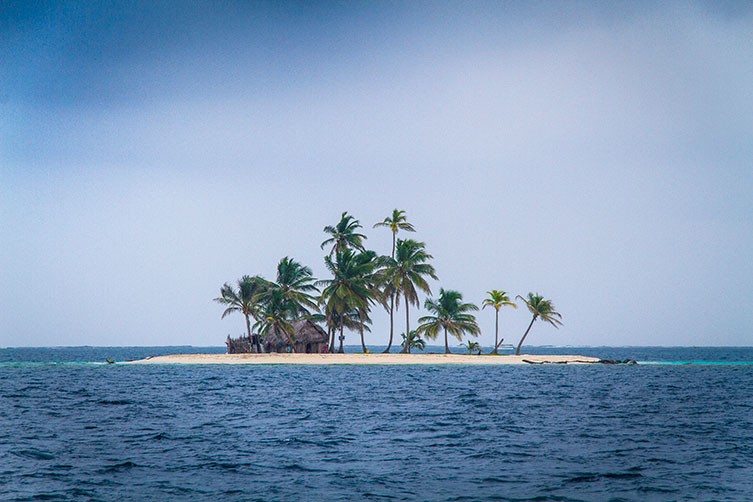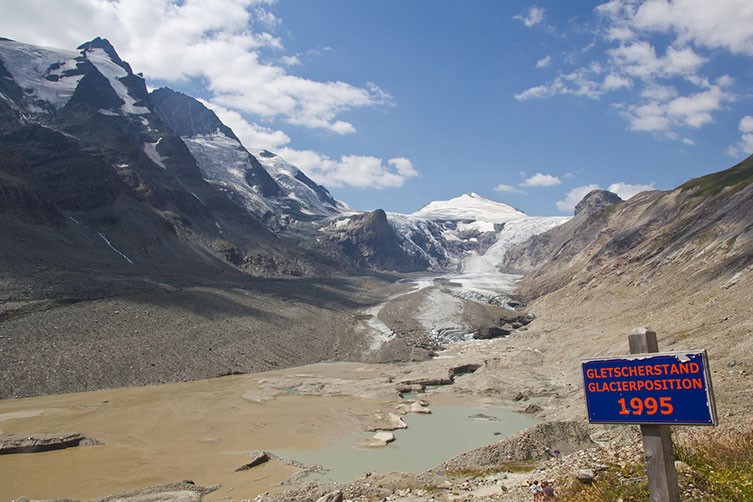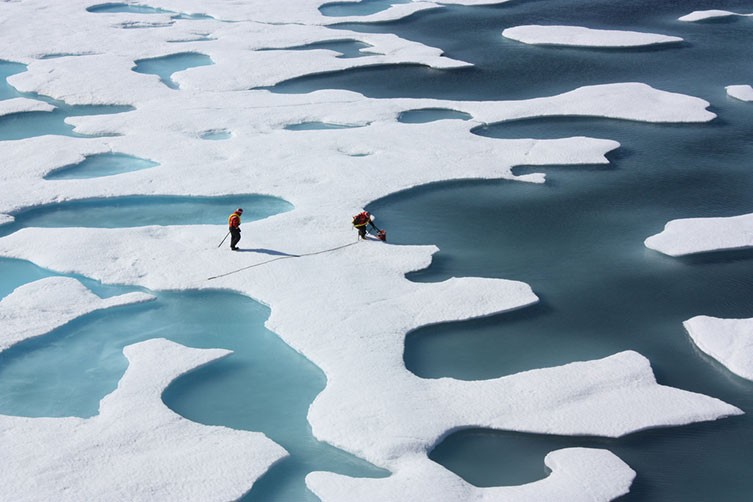Create a list of articles to read later. You will be able to access your list from any article in Discover.
You don't have any saved articles.

A woman steps off a bus onto a street in Dharga Town, Sri Lanka, which was flooded by heavy monsoon rains in 2010 © Hafiz Issadeen via Flickr (CC BY 2.0)
Climate change is the defining issue of our time. We have reached a pivotal moment in deciding our planet's future.
Find out what climate change is, why it matters and what it could mean for our collective future.
Weather refers to atmospheric conditions, such as rain or snow, happening in a place at a specific moment in time. Climate is how much, on average, a type of weather will occur over a longer period.
Dr Joeri Rogelj is a climate scientist at Imperial College London's Grantham Institute who has contributed to and led several major climate change assessments. He explains, 'Climate change is how the characteristics of the weather we experience in a certain place change.
'It can get hotter or wetter on average or have more concentrated rain in a short period, but then get longer dry periods. All of that can be a result of climate change.'
Global warming is a term used interchangeably with climate change, although the latter is preferred because the warming atmosphere and oceans are just some of the effects we see.
'It's not just about temperature. Places are also becoming wetter or drier, and in some the seasons are moving. Most importantly, in a few regions and seasons, it may actually at times be cooler than we're used to. That's confusing if you just talk about global warming.'

This is Typhoon Utor, which affected the Philippines and China in 2013. It caused considerable damage and loss of life. Climate change influences most weather events, including tropical storms and hurricanes. © NASA Goddard Space Flight Center via Flickr (CC BY 2.0)
The main driver of current climate change is the emission of greenhouse gases, most importantly carbon dioxide and methane. These are primarily released when fossil fuels are burnt. Meat and dairy production, producing cement and some industrial processes, such as the production and use of fertilisers, also emit greenhouse gases.
Greenhouse gases trap heat in our atmosphere. Since the mid-nineteenth century, the world has emitted over 2.2 trillion tonnes of carbon dioxide.
Joeri explains, 'Energy from the Sun falls on our planet and normally gets reflected back as infrared radiation. But instead of escaping back out into space, this radiation gets absorbed by molecules of greenhouse gases, which then emit them in all directions.'
This process causes more heat to be kept near Earth's surface, warming our world.
There are measuring stations all around the world that keep track of air and sea temperature. From these measurements it's clear that temperatures are rising.
'There are many more indicators that tell us that the Earth is warming. For example, on a warming planet we would expect polar ice caps and glaciers to melt. It is clearly observed that those are melting,' explains Joeri.

This image of an iceberg in McMurdo Sound was captured in 2017 as part of NASA's Operation IceBridge. This is an ongoing airborne mission to monitor changes in polar ice. © NASA Goddard Space Flight Center via Flickr (CC BY 2.0)
We know that greenhouse gases are causing change. Thanks to studies that look at how carbon dioxide absorbs infrared radiation, for example, there is a scientific understanding of how the planet would warm as a result of emissions. This has allowed climate scientists to discount the theory that global warming is being caused by an increase in the Sun's intensity, for example.
It's also known that greenhouse gases are primarily emitted by fossil fuel combustion.
'To burn carbon and produce carbon dioxide, you need oxygen. The amount of oxygen that is in the atmosphere is reducing at exactly the right amount for the increase in carbon dioxide to be caused by combusting fossil fuels,' explains Joeri.
There is additional evidence in the ratios of different types of carbon. Fossil fuels are, essentially, ancient plants. Plants now and in the past preferentially take up carbon-12. In normal conditions, the ratio between carbon-12 and carbon-13 is constant.
'What we can see is that the ratio of carbon-13 in our atmosphere is going down at exactly the rate you would predict if the carbon dioxide increase was due to burning fossil fuels.'

Scientists predict that climate change will cause extreme weather events such as wildfires, floods and hurricanes to become worse © Quarrie Photography via Flickr (CC BY-NC-ND 2.0)
Climate change does not have the same effects everywhere. The planet is generally getting hotter, but some regions and seasons can at times be temporarily cooler. Some places will see drawn-out seasons, while others may experience concentrated bursts of extreme weather.
Extreme weather events - such as hurricanes, floods, heatwaves, drought and wildfires - are predicted to become more intense and frequent.
'Pretty much any weather event is influenced by climate change. As scientists we can estimate how much climate change has made a certain event more likely or more intense than it would have been without climate change,' explains Joeri.
When the world warms, ice melts. Arctic sea ice could disappear entirely in a warming world, and Greenland and Antarctica's ice sheets could be destabilised. This would result in large sections melting, which would add more liquid to the ocean.

Sea level rise caused by climate change is a threat to low lying islands such as Panama's idyllic San Blas Islands, 49 of which are inhabited © Marc Veraart via Flickr (CC BY-ND 2.0)
Ice also reflects the Sun's energy, so without ice, more heat is absorbed by the ocean. Water expands as it warms - this is known as thermal expansion. This effect means that the ocean takes up more space, causing sea levels to rise. Even with rapid emission cuts, sea levels are expected to rise by around 26 to 53 centimetres by 2100.
Along with melting ice sheets and glaciers, rising global temperatures could cause rainforests to die and widespread species extinctions.
How climate change will affect you depends on who you are and where you live.
Around 190 million people currently live in areas that, due to rising sea levels, are expected to be under high tide levels by 2100. This could cause a massive displacement of populations. Low lying atoll nations such as Tuvalu and the Maldives are incredibly vulnerable to this change and could be lost to the sea.
Hundreds of millions of people rely on seafood as their main source of protein. Warming and more acidic waters could destroy marine food chains by affecting their base, such as krill or coral reefs.
Longer-lasting drought could devastate crops, threating food security. Reservoirs drying up, as well as the loss of glaciers, could make drinking water scarce.

Pasterze Glacier is estimated to be receding at a rate of 10 metres per year. A sign shows where the glacier lay in 1995, with the ice having since dramatically retreated up the valley. © H Raab via Flickr (CC BY-NC-ND 2.0)
Increased precipitation can cause deadly flooding, as well as lowering indoor air quality. This could affect our health as dampness benefits moulds and fungi.
Around four billion people live in urban areas, and by 2050 this will have risen to an estimated 6.7 billion.
City dwellers are not exempt from climate change's effects. Urban populations usually rely on rural areas for inputs such as food and water. If climate change disrupts these important connections, it could heavily affect those in urban areas.
Natural disasters impact poor and vulnerable populations disproportionately hard and clearly expose the consequences of ignoring social inequalities. With extreme weather increasing, these populations face a heightened level of risk.
For example, the urban heat island effect amplifies the effects of temperature extremes in cities. Those unable to afford to buy and run air conditioning may find their health compromised.
The hazards of climate change also do disproportionate harm to women and girls.
Joeri says, 'We don't know what will happen when, exactly. It's really hard to anticipate, particularly for populations that are already on the edge every year.'
People are also seeing climate change impact their mental health, experiencing a phenomenon known as eco-anxiety.

Differences in wealth, ethnicity and health are just some of the inequalities that could determine a person's vulnerability to the effects of climate change © Kompas/Hendra A Setyawan via World Meteorological Organization Flickr (CC BY-NC-ND 2.0)
The natural world is delicately balanced. No species - including ours - is completely independent of all others. A 2019 report confirmed that over one million animal and plant species are now at risk of extinction as a result of human activities.
In the UK, an analysis of over 700 species has shown that more than 80% of trends between 1976 and 2005 indicate seasonal events are happening earlier. Differing rates of change could mean that species' lives are no longer synchronised with those they rely on.
Many plants are flowering earlier. Migrating birds arrive earlier, leave later and some even are getting smaller. Butterflies are emerging earlier. Birds and amphibians are laying their eggs earlier in the year. Some species are moving into new areas, such as kelps which form vital marine habitats.

Seaweeds are important for many reasons. They act as vital habitats. Some also help protect coastlines from erosion.
Insects are one of the most vulnerable groups, with less ability than mammals or birds to escape warmer temperatures. Loss of insects, which are a primary food source for many animals, a key pollinator of plants and whose numbers are already plummeting, could cause the ecosystem to collapse.
In aquatic ecosystems, activities to mitigate the side effects of climate change, such as building hard flood defences, can have negative effects. As sea levels rise, sea walls reduce the space for intertidal ecosystems. A rising sea could also damage important coastal habitats like sand dunes and cliffs.
Joeri says, 'The ocean looks homogenous, but it also experiences variations. There are ocean heatwaves, where if a particularly warm mass of water comes to an area like coral reefs, it induces loss and mass dieback.'
The loss of Arctic sea ice takes away a key habitat from animals including polar bears, seals and walruses. The ice is now declining at a rate of more than 12% per decade.
Climate change is just one of the stressors currently impacting nature. Sea use, invasive species, pollution and the exploitation of organisms are all factors in the threat to nature. Without drastic changes, it's expected that there will be devastating changes in biodiversity and ecosystems.
Find out more about the link between climate change and the biodiversity crisis.

A warming planet and melting ice threatens the survival of iconic animals such as polar bears © Gary Kramer/USFWS via U.S. Fish and Wildlife Service Flickr (CC BY 2.0)
Climate change has been a known problem for around 30 years. Starting to fix it earlier might have made this daunting task much easier.
Joeri says, 'We definitely know how to reduce emissions to a significant degree. We are seeing more impacts of climate change, but we can also see a heightened interest and concern in the general public.
'Ultimately, reducing emissions is really an issue of public and political will.'

By understanding more about the planet, such as by studying the poles, scientists are able to estimate the consequences climate change will have © NASA Goddard Space Flight Center via Flickr (CC BY 2.0)
Over the past decades, scientists have estimated the potential impacts of the planet's average temperature rising by different amounts.
'Based on that information, governments have come together and decided that they don't want to exceed a 2°C rise. They want to be well below that and pursue efforts to make it as close as possible to 1.5 °C.'
The difference in outcomes between 1.5 and 2°C are considerable. The impacts are the difference of 70% or 99% of coral reefs dying or a summer free of Arctic sea ice once every 100 or 10 years.
Scientists have determined how much carbon dioxide can still be emitted before this temperature rise limit will be exceeded. This is called the carbon budget and it's relatively small.
Joeri says, 'It's currently 420 to 580 billion tonnes of carbon dioxide for having a two-in-three or a one-in-two chance of limiting warming to 1.5°C, starting to count in 2018.
'Today we are roughly emitting 42 billion tonnes a year. So, if you start today and are going to net-zero emissions, if you want a one-in-two chance, we should there by around mid-century.
'These numbers define the geophysical requirement. Scientists then use engineering and economic models to understand how we can transform society to stay within that emission limit.'

There are many ways that you can help the planet. One way is by reducing the amount of meat and dairy you eat. © Theo Stikkelman via Flickr (CC BY 2.0)
This transformation could include changes such as increasing the share of energy produced by renewables, changing the way food is produced, changing our diets to have a lower carbon footprint and changing the way we build houses and design cities.
Moving to net-zero emissions will not be a perfectly co-ordinated transition. It will take some countries to lead and show the world that moving to this new way of living and functioning is both possible and beneficial for other sustainability objectives, such as public health and food security.
But on whether we'll ever see a change for the better, Joeri says he's hopeful.
'Preferably we would have started 25 or 30 years ago, but I will take any year at which we start declining steadily towards net-zero.'